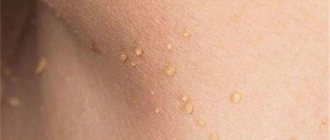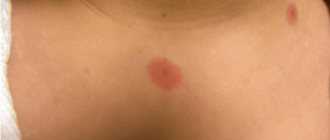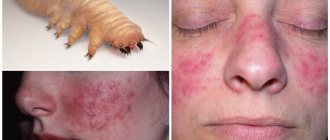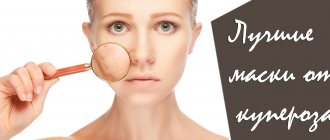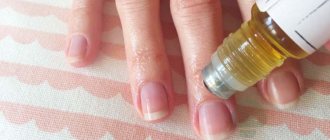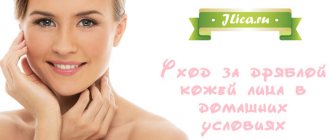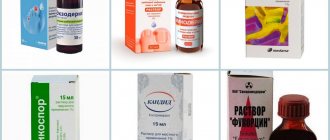Dermatovenerologist
Khasanova
Alina Rashidovna
7 years experience
Make an appointment
Ring-shaped erythema is a multiform lesion of the skin, a characteristic feature of which is the appearance of ring-shaped spots and rashes on the skin. The skin color of the affected areas changes and becomes red, bright pink or bluish. Depending on the causes of the disease, swelling, local fever and other manifestations of the disease may be observed. Changes in skin color occur due to the expansion of the lumen of the blood capillaries penetrating the connective tissue and the associated stagnation of blood.
Ring-shaped erythema - characteristics
ring-shaped erythema photo
Erythema annulare - another name for centrifugal annular erythema is a chronic toxic-allergic or infectious-allergic disease. A distinctive feature is the formation of non-flaky spots on the skin, which tend to form lesions in the form of rings.
The absence of itching or other subjective sensations can lead to the patient not noticing the appearance of centrifugal erythema. Ring erythema is extremely dynamic and can appear and disappear within two hours.
The cause of the disease is foci of chronic infection (sinusitis, tonsillitis), candidiasis, mycosis, diseases of the gastrointestinal tract, endocrine disorders.
Erythema annulare appears in the form of small, non-flaky, ring-shaped spots. The color of the spot is pale pink. As they increase in size, the erythema retains its shape. New formations may appear inside the rings. In this case, the spot is slightly concave in the center and raised at the edges.
Translated from Greek, “erythema” means redness. Color changes are caused by internal and external factors. Erythema has a wide variety:
- Ring-shaped erythema;
- Multimorphic erythema;
- Toxic erythema;
- Erythema nodosum;
- Erythema multiforme.
The diameter of the rash ranges from a few millimeters to 10 cm. The rash is located on the patient’s shoulders, torso, and rarely on the forearms, legs, thighs, neck, and face. A characteristic feature is the absence of spots on the palms, soles of the feet, and mucous membranes.
Ring-shaped erythema: treatment is based on eliminating the factors that lead to the occurrence of erythema. The prognosis for this type of erythema is favorable. It is recommended to sanitize foci of chronic infection and stabilize the functioning of the gastrointestinal system.
Source: serdcemed.ru
Causes of development and predisposing factors
An outbreak of annular erythema can be triggered by pathological conditions, external and internal factors:
- acute poisoning with toxic substances,
- hereditary predisposition,
- viral or bacterial infection,
- infectious processes localized at the site of the rash (inflammation and purulent bone lesions, tonsillitis, granulomas),
- acute and protracted forms of sinusitis,
- chronic inflammation of the gallbladder,
- purulent-inflammatory processes in bone tissue and bone marrow,
- fungal infection of the genitals, feet, mucous membranes of the mouth and nose,
- rheumatoid diseases,
- dysfunction of the thyroid gland and endocrine system,
- gastrointestinal pathologies,
- suppressed immunity,
- benign and malignant tumors,
- blood diseases,
- heart attack,
- collagenosis
Erythema can occur as a side effect of certain medications.
Types of erythema
This disease can appear in both men and middle-aged women. In children, ring-shaped erythema may be a specific manifestation of rheumatism. Such cases occur in 10 percent of children. In rheumatism with heart damage in children, cases of Leiner's annular erythema are known. Erythema disappears as a result of treatment of the underlying disease
Erythema nodosum
This type of skin disease is called a regular pathology of connective tissue, in which the skin and fatty tissue located under it are damaged. Patients notice a moderately spreading rash on their body, similar to compacted nodules. Their diameter can range from 0.5 to 5 cm or more. When touched, they cause pain.
The nodular type of disorder can occur at any age, both in children and adults. However, the child suffers this disease much more severely. It can occur in two forms:
- Spicy. With it, the general condition of the patient worsens, body temperature rises, redness appears on the neck, knees, legs, and it is rare to see such a rash on the face. The color of the nodules is red, but it can change, acquiring a purple, brown and yellowish tint. Most patients are accompanied by an inflammatory process in the joints. The disease in this form can bother the patient for 6-7 weeks.
- Chronic. This type does not last long. A characteristic feature of this course is that the nodules can merge with each other, and also appear again in old places.
Alternative medicine can also be used to relieve symptoms. You can add some grains, herbs to your daily diet. These can be green beans, kidney beans, basil, dill, cumin. If swelling occurs, it is recommended to drink diuretics.
The rash, which is presented just above, is treated with the following groups of medications:
- non-steroidal drugs aimed at suppressing the inflammation process, for example, Nimesil, Indomethacin;
- hormonal drugs, for example, Prednisolone;
- potassium iodide, it is taken orally only if there are no contraindications;
- antibiotics if there is an infection in the body.
In addition to medications, there is also local therapy, which consists of using Heparin ointment.
In acute cases, it is also important to adhere to semi-bed rest and a milk-vegetable diet. When the disease subsides, you should not subject your body to physical activity for at least a month.
Exudative erythema
This type of disease is represented by manifestations on the skin, which appear in the form of pinkish spots and reddish papules. It should be noted that if you do not get rid of them in a timely manner, they can increase in size up to 3 cm, and sometimes more. Such a lesion tends to merge and can develop inside each other.
This rash may appear on the arms, legs, and genitals. At the same time, it is quite painful, causing severe itching and burning. This type of skin disease can be encountered in both children and adults.
The exudative variety begins to develop, causing the patient many unpleasant symptoms. The person complains that:
- suffers from fever;
- severe headache;
- there is general weakness in the body, as well as pain in muscle tissue;
- no desire to eat;
- sore throat, cough;
- bothered by a skin rash;
Thus, the exudative type of skin disease in almost all cases is an allergic reaction. In this regard, it is first necessary to completely eliminate the source of the allergen in order to prevent its contact with the patient.
Medication assistance consists of a doctor prescribing the following medications:
- enterosorbents taken if the cause of an allergic reaction is food components;
- antibiotics, which are prescribed if the disease appears due to a staphylococcal or streptococcal infection;
- corticosteroids, used only for severe pathology;
- vitamins, namely group B products, ascorbic acid, potassium preparations.
In addition, the patient may need antifungal medications, presented in the form of ointments, aerosols aimed at eliminating pain, as well as antiseptic drugs.
There is no need to panic too much if exudative rashes are detected. The main thing is to start treatment on time, then the prognosis for recovery is quite favorable. It is also worth remembering that therapy should be carried out exclusively under the supervision of the attending physician.
Erythema multiforme
This type of disease causes the appearance of spots that are characterized by clear boundaries and can grow from a few mm to 1.5 cm. They can merge with each other, resulting in a pattern resembling a garland.
Patients note that a rash appears on the legs and hands, and it is located symmetrically. As the skin lesion develops, it affects an increasingly larger area of the skin and oral mucosa, appearing in waves depending on the degree of pathology.
The spots are red-blue in color and slightly raised relative to the surface of the skin. It is also observed that there is depression in the center of the lesion. Such a lesion causes a wide variety of rashes: papular, macular, vesicular or bullous.
If the patient is concerned about a mild form, the doctor prescribes medications that eliminate the inflammatory process and drugs that prevent or mitigate an allergic reaction. Local treatment can also be carried out if a person has damage to the oral mucosa. In this case, rinse with an aqueous solution of Ethacridine Lactate (Rivanol 0.1%) is prescribed.
In order to eliminate pain that occurs during meals, the specialist prescribes Lidocaine. To provide external medical care, ointments and wet-dry dressings with desensitizing agents are used.
If the patient suffers from a severe form of the disease, then the treatment plan also includes taking glucocorticoid drugs, for example, Prednisolone. They suppress the activity of the exudative inflammatory process developing in the tissues.
If a herpes virus infection is observed, Acyclovir is recommended. If the pathology manifests itself again, then treatment with antibiotics should be carried out.
If the initial stage of the lesion is detected, the prognosis for recovery is quite favorable. How successful the therapy will be depends on the individual characteristics of the body, the condition of the patient’s internal organs and mucous membranes.
Erythema infectiosum
This type of disease is a pathology that is caused by pathogenic microorganisms. Patients suffering from this disease experience general intoxication of the body and rashes. In most cases, a fever appears first, and then a skin rash begins to appear, after which the fever gradually goes away.
Rashes on the skin of the infectious type differ in intensity and predisposition to merge with each other. In some cases, the pathology manifests itself in the form of nodules or vesicles. Rashes also appear on the face, causing redness to spread across the cheeks, as if they had been spanked.
On the arms and legs, the lesion looks more like a lace, which consists of round spots, rings and half-rings, merging with each other.
The basis for identifying an infectious skin disease is the nature of the rashes, as well as where they are located. But this does not determine which treatment plan will be used. Patients usually carry out therapy at home. They may be admitted to the hospital if a rash is detected in a child or in a person who is seriously ill with this disease or suffers from complications of this disease.
No special help is needed in this case. The goal of therapy is to get rid of the disturbing symptoms of the pathology.
In this regard, the doctor prescribes medications such as:
- drugs aimed at suppressing an allergic reaction;
- antipyretic drugs, which will be required if the patient is febrile;
- medications that relieve pain if the patient complains of severe joint pain.
In some people, this disease occurs in a rather severe form, then glucocorticosteroids are included in their treatment plan. They can also be prescribed if the patient suffers from severe somatic pathologies and also has a weak immune system.
Ring-shaped erythema
This type of disease is called a disease in which ring-like spots grow eccentrically on the skin. This disease occurs in a chronic form and has an infectious-toxic nature.
The symptoms of the pathology are acute in nature, despite the fact that they themselves are chronic and long-lasting.
First, patients notice flaky spots on their body that have a red or pink-yellow tint. As the disease progresses, the rash in adults becomes ring-shaped and begins to itch and burn. They may be slightly higher than the surface of the skin. The rash can grow up to 15 cm in diameter.
The main goal of therapy for such erythema is to eliminate the cause that caused the progression of the disease. In addition, it is necessary to sanitize infectious foci in the body. If the patient still has concomitant health problems, then their treatment is mandatory.
A doctor may prescribe the following medications for therapy:
- anabolics;
- calcium and sodium thiosulfate preparations;
- antihistamines used to treat the affected areas;
- antibiotics with a wide spectrum of action to eliminate infectious infections;
- corticosteroids;
- compresses that need to be applied to painful areas;
- medications that have an antiseptic and disinfectant effect;
- vitamins;
- ointments for topical use to activate epithelization;
- homeopathic medicines;
- aerosols for treating lesions containing sodium thiosulfate.
In children, the ring type is diagnosed quite rarely. It is treated absolutely the same for any age.
The appearance of a skin disease always causes discomfort to the patient, especially if it occurs in young children. One of the varieties of such pathologies is erythema, the photos, symptoms and treatment of which are worth considering in more detail.
Erythema toxicum of the newborn
This type of skin disease is a pathology that causes polymorphic rashes on the human body. The disease most often occurs in newborns; in rare cases, it can be observed in adults.
The toxic type of erythema in most cases begins to appear in breastfed babies. Babies whose mothers feed formula have a minimal risk of developing this disease.
According to medical statistics, erythema occurs in half of babies who are a few days old. The reason for this is that the child goes through a process of adaptation to the environment and its external factors.
Doctors observe the following symptoms in newborns:
- redness, peeling of the skin;
- dilation of blood vessels;
- the appearance of large or medium-sized pink spots on the skin;
- the appearance of pimples, ulcers, blisters with clear liquid inside;
- formation of compacted rashes;
- increased body temperature;
- deterioration of the child's general condition.
As a rule, this pathology does not require any specific medical assistance, because the rash ceases to bother you after its cause is eliminated. However, sometimes the doctor has to prescribe medication and physical therapy.
Source: syp-foto.ru
Erythema Daria: its main differences
How it manifests itself
Depending on the species, signs and symptoms may vary. Common characteristic features of erythema annulare include:
- red ring-shaped formations;
- the size of the “drawing” starts from 1 cm to 20 and more;
- Common locations of the rash include the face, neck, thighs, legs, shoulders, abdomen, chest;
- spots may rise above the skin;
- itching;
- burning;
- paroxysmal (after old spots disappear, new ones may appear);
- The inside of the ring does not change color, but may fade.
In children
In children, erythema is characterized by the appearance of red spots on the skin. Over time, the center of the formed ring brightens, sometimes becoming pale. Next to one spot, another or more may appear.
The skin on the affected areas becomes dry to the touch and peels. A blistering rash occurs along the edge of the spot. In addition to the general characteristic symptoms, children may experience fever, weakness and loss of appetite. In most cases, the onset of the disease is painless, even for a child.
In adults
Differential diagnosis
Depending on the symptoms of the disease, scaly annular, vesicular migratory, simple annular and persistent erythema are distinguished. To clarify the diagnosis and prescribe treatment, contact a dermavenerologist or dermatologist. The diagnostic process will differ depending on the specific variant suspected.
Diagnosis of erythema annulare involves the following tests;
- histopathological examination;
- mycological;
- biopsy of the affected area;
- general and biochemical blood test;
- serological study;
- checking the material for the presence of cancer cells.
Flaky ring-shaped
The scaly or squamous type of the disease is characterized by peeling of the edging of the affected areas of the skin. In this case, a border of small vesicles is often observed around the spot. The edge of the ring has an elevation above the cover.
Diagnosis of the variety involves histological examination. It is necessary to prevent mistakes. Manifestations of scaly erythema are similar to the symptoms of granuloma.
Vesicular migratory
This type of erythema occurs due to a tick bite. Carrying out an enzyme immunoassay of blood from a vein is the main and mandatory type of diagnosis.
To exclude the possibility of meningitis, a lumbar puncture with further examination of the cerebrospinal fluid is prescribed.
Simple annular erythema
Symptoms
The manifestations of this disease are acute, even with a characteristic chronic course. Red or pinkish spots form on the body, which peel off on the surface and persist in the form of rounded lesions protruding above the skin.
Along the outer edges, the rings have a bright red, almost purple tint with a diameter of up to 15-20 centimeters or more.
Where the rash is localized, the patient often experiences itching. Elements of annular erythema can change in size and take on different shapes.
Pathology can cause general symptoms characteristic of other types of diseases. The patient experiences attacks of headaches, general poor health, fluctuations in body temperature, and swelling may be detected throughout the body. These symptoms, as well as changes in the skin, cause great discomfort, especially if you have had hypopituitarism for a long time.
Main forms of pathology:
- In the scaly clinical form, symptoms appear in the form of scaly lesions around the edges
- The vesicular form causes the appearance and rapid disappearance of rounded cavities containing fluid and protruding above the skin along the edge of the lesions.
- Erythema in the form of garlands and micro garlands is characterized by symptoms in the form of rashes for several hours or days
Ring-shaped erythema is characterized by protracted development and treatment, while the scalloped rash persists for up to three weeks. After this, the lesions disappear, but changes in pigmentation remain.
Over time, the ring-shaped formations appear again, causing a burning sensation of varying intensity. The disease is most often localized in the torso and limbs, but also occurs in other parts of the body.
Source: asclepii.ru
Types and forms of the disease
The classification divides ring-shaped erythema into 3 types.
- Rheumatic. Rashes appear as one of the symptoms of rheumatism. Patients of childhood and adolescence are more susceptible to the occurrence of a rash of this etiology. The plaques are similar in appearance to light pink round spots, difficult to distinguish against the background of healthy skin.
- Migratory. Plaques appear when the body is damaged by bacteria or viruses. Occurs in a chronic form. Symptoms of inflammation alternate with dermatosis.
- Centrifugal. The etiological nature of the disease has not yet been identified. Manifests itself as numerous plaques on the skin. The spots rise slightly above the cover and resemble light pink tubercles. Over time, the loose elements increase in size and change location and shape.
Based on clinical signs, the following forms of pathology are distinguished:
- flaky - a characteristic difference is the flaking of plaques around their circumference,
- vesicular - characterized by the spontaneous appearance and no less unexpected disappearance of vesicles (convex cavities with liquid contents along the perimeter of the affected area),
- simple garland-shaped - characterized by short-term rashes that remain on the body from 2 hours to 2-3 days,
- persistent microgarland-like - the rash persists for a long time, the diameter of the plaques does not exceed a centimeter.
Each form of ring erythema differs in clinical signs and course. A dermatologist can determine the exact type.
Diagnostics
The difficulty of diagnosing ring-shaped erythema is that the symptoms of the disease resemble dermatological manifestations of other diseases. First, it is necessary to conduct serological tests to exclude syphilis, since this disease is characterized by skin rashes resembling rings and ovals in shape.
During a histopathological examination of the dermis with annular erythema, one can notice tissue swelling, as well as the presence of a perivascular infiltrate of lymphocytes. When making a diagnosis, it is important to exclude diseases such as:
- Seborrheic eczema
- Pink lichen of Zhiber
- Multimorphic exudative erythema
- Dühring's dermatitis
- Sarcoidosis
- Tertiary syphilitic roseola
- Cholinergic urticaria
The patient is prescribed a serological examination to ensure the absence of syphilis, against the background of which spots similar in shape and structure are formed. Establishing a diagnosis can be difficult, so the doctor must, during the examination, exclude all skin diseases with similar manifestations. After the conclusion, the patient is prescribed an examination to find out what the causes of annular erythema are.
The disease in children manifests itself in the form of round spots that merge into rings and have different shades of red along the edges. The colored stripes rise slightly above the skin area, but pallor remains inside the lesion.
The causes of rashes in children are toxic or allergic in nature and are more often observed among children with rheumatism or abnormalities of the heart muscle. Often children show no further symptoms other than spots on certain areas of the body, which may take several years to appear.
Source: biokrasota.ru
Causes of the disease
There are many diseases and conditions that can cause erythema annulare, since it is not an independent disease and always occurs against the background of some pathological process. Skin manifestations most often develop against the background of:
- accumulation of toxins in the body;
- rheumatism;
- fungal, viral or bacterial infections;
- chronic inflammatory diseases;
- dysfunction of the endocrine gland;
- tuberculosis;
- borreliosis;
- reducing the protective function of the immune system;
- allergic reaction;
- cancer;
- helminthic infestation;
- taking certain medications.
In addition, in many cases, Darier's annular erythema occurs for no apparent reason in completely healthy people.
Treatment
The course of treatment for annular erythema is aimed at treating the primary infection using medications that reduce the symptoms of the disease. After prescribing antibiotics, sulfonamides and vitamin complexes, the patient's condition improves significantly.
Children and adults undergo clinical observation, during which additional local treatment is prescribed - corticosteroid ointments. If you follow all the recommendations, getting rid of ring-shaped erythema is quick and favorable.
Darier's erythema on the back A tick bite can cause the appearance of rings that gradually increase in size. At the site where the spots form, the patient experiences severe itching due to burning and pain.
The pathology in most cases is located on the lower extremities, abdomen, lower back, armpits, groin area and neck. In addition to the primary lesions, the bite provokes the appearance of many other rashes, but they are smaller in shape. A crust appears in the center of the lesion, which scars over time.
Erythema migrans is a very dangerous form of skin disease, so its treatment must be immediate.
The patient's body temperature may rise, the lymph nodes may become thicker, and the spots may enlarge. Successful treatment is based on the use of broad-spectrum antibiotics at an early stage after detection of the disease. Independent local treatment of annular erythema with dermatological ointments and other drugs is contraindicated.
These include regular air baths and lubricating the rashes with special medications. A very important point that all breastfeeding mothers should pay attention to is their diet. You should not eat foods that can cause an allergic reaction in a child.
In order to cure long-lasting erythema, the doctor may prescribe antihistamines, biological preparations that include lactobacterin, vitamins E, B6 and C, and rutin.
If the rash is observed mainly in the umbilical cord area, then doctors advise treating the pustules with an alcohol solution. You can also do cauterization with brilliant green, 5% potassium solution. After carrying out this treatment, you will need to powder the area with powder or talcum powder.
In addition, the doctor may prescribe a glucose solution and medications containing potassium. In addition to direct treatment of the patient’s skin, it is necessary to give him plenty of water and walk in the fresh air.
It is worth noting that the toxic rash is not considered dangerous for the child. If the pathology causes an intense and extensive rash, which leads to the appearance of a weeping crust, then medical attention should be immediate.
Having looked at what erythema is, photos, symptoms and treatment of this disease, each person will be armed with the necessary information. But if this disease manifests itself, it is still best to consult a doctor.
Any manifestation on the skin causes discomfort to a person, so you must always carefully monitor your health. Under no circumstances should skin rashes that arise be left unattended; it is best to visit a doctor who will tell you exactly whether you should worry about it and what measures need to be taken.
Source: syp-foto.ru
Folk remedies and recipes
In parallel with traditional remedies, herbal treatment methods can be used. Proven recipes:
- pour 2 tablespoons of dry arnica into a heated thermos, pour in 2 cups of boiling water. Close the container and, wrapped in a blanket, leave for a day. Drink the strained infusion 5 times a day, 1 teaspoon. Store the product in the refrigerator;
- Grind 100 g of dry arnica root into powder. Add an equal amount of melted pork or goose fat. Keep the mixture in a water bath for 3 hours, stirring from time to time. Place the product in a porcelain or glass container and seal tightly. Treat erythema 3 times a day
- 10 g of dry white mistletoe pour 0.5 liters of alcohol. Leave for a month, shaking the bottle periodically. Filter means. Take 25-30 drops every day in the evening before meals with water. Drink it for a month, take a break, and after 30 days you can take a second course. Mistletoe is poisonous, so it is very important to control the dosage.
For more successful treatment, it is important to normalize the functioning of the gastrointestinal tract. It is necessary to regularly make mint, lemon balm or lingonberry tea. Take the product before meals or in between meals. You need to drink at least 1 glass per day.
Source: vseokozhe.com
Prevention and prognosis
Ring-shaped erythema is a chronic pathology with a positive prognosis. Treatment will produce more effective results if started as early as possible. Erythema does not degenerate into malignant, but it must be treated.
In advanced cases, surface erosions may appear at the sites of formations, which, when healing, leave pigment spots. Preventive measures:
- Timely identify and treat infectious and fungal diseases.
- Monitor the proper functioning of the gastrointestinal tract, and if problems arise, get examined and treated.
- Monitor your medications and, in case of allergies, stop taking them.
- Avoid skin contact with chemical irritants.
- Eat right, give up bad habits.
Ring-shaped erythema is one of the skin diseases, the origin of which is not fully understood. You cannot make decisions on your own about how to treat a disease. Only under the supervision of an experienced doctor can an effective result be achieved.
Source: vseokozhe.com

